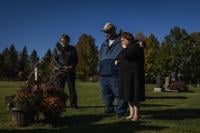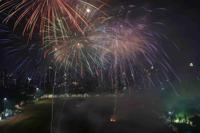SEOUL, South Korea (AP) — North Korea launched a new intercontinental ballistic missile Thursday in its first test in almost a year of a weapon designed to threaten the U.S. mainland and occurring days ahead of the U.S. election.
North Korean leader Kim Jong Un ordered the missile test and was at the launch site, calling the launch “an appropriate military action” to show North Korea’s resolve to respond to its enemies’ moves that has threatened the North’s safety, according to its Defense Ministry.
The United States, South Korea and Japan had also identified the weapon as an ICBM and condemned the launch as raising tensions. The launch came as Washington warned that North Korean troops in Russian uniforms , likely to augment Russian forces and join the war.
North Korea confirmed the launch hours after its neighbors detected the firing of what they suspected was a new, more agile weapon targeting the mainland U.S. The statement was unusually quick since North Korea usually describes its weapons tests a day after they occur.
“I affirm that the DPRK will never change its line of bolstering up its nuclear forces,” Kim said, according to a North Korean Defense Ministry statement carried by state media. DPRK stands for the Democratic People’s Republic of Korea, North Korea’s official name.
South Korea's Joint Chiefs of Staff said North Korea could have tested a new, solid-fueled long-range ballistic missile. Missiles with built-in solid propellants are easier to move and hide and can be launched quicker than liquid-propellant weapons.
JCS spokesperson Lee Sung Joon said the launch was possibly timed to the U.S. election in an attempt to strengthen North Korea's future bargaining power. He said the North Korean missile was launched on a high angle, apparently to avoid neighboring countries.
Japanese Defense Minister Gen Nakatani told reporters the missile's flight duration of 86 minutes and its maximum altitude of more than 7,000 kilometers (4,350 miles) exceeded corresponding data from previous North Korean missile tests. Lee, the South Korean military spokesperson, said South Korea has a similar assessment on Thursday's launch.
KCNA said the flight characteristics of this launch exceeded those registered for its previous missile launches but did not detail the differences.
U.S. ��ɫֱ�� Security Council spokesperson Sean Savett had called the launch “a flagrant violation” of multiple U.N. Security Council resolutions that “needlessly raises tensions and risks destabilizing the security situation in the region.” Savett said the U.S. will take all necessary measures to ensure the security of the American homeland and its South Korean and Japanese allies.
Both South Korea and Japan condemned the North Korean launch for posing a threat to international peace and they said they're closely coordinating with the U.S. over the latest North Korean weapons test. Lee said that South Korea and the U.S. plan “sufficient” bilateral military exercises and trilateral ones involving Japan in response to North Korean threats.
Lee said the missile may have been fired from a 12-axle launch vehicle, the North's largest mobile launch platform that it disclosed in September. The vehicle's unveiling had prompted speculation North Korea could be developing an ICBM that is bigger than its existing ones.
North Korea has made strides in its missile technologies in recent years, but many foreign experts believe the country has yet to acquire a functioning nuclear-armed missile that can strike the U.S. mainland. They say North Korea likely possesses short-range missiles that can deliver nuclear strikes across all of South Korea.
One of the technological hurdles North Korea still faces is for its weapons to be capable of surviving the harsh conditions of atmospheric reentry. South Korean officials and experts earlier said North Korea may test-launch a ICBM on a normal angle to verify that capability.
Lee said a high-angle launch like Thursday's test cannot examine a missile's reentry vehicle technology. He said that more analysis is required to find why North Korea didn't conduct a standard-trajectory launch on Thursday.
South Korea’s military intelligence agency that North Korea was close to test-firing a long-range missile capable of reaching the United States and has also likely completed preparations for its seventh nuclear test.
North Korea last test-fired an intercontinental ballistic missile in December 2023, when it launched the solid-fueled Hwasong-18.
In the past two years, Kim has used Russia’s invasion of Ukraine as a window to ramp up weapons tests and threats while also expanding military cooperation with Moscow. South Korea, the U.S. and others have recently accused North Korea of dispatching thousands of troops to support Russia’s warfighting against Ukraine. They've said North Korea has already shipped artillery, missiles and other convectional arms to Russia.
North Korea's possible participation in the Ukraine war would mark a serious escalation. South Korea, the U.S. and their partners also worry about what North Korea could get from Russia in return for joining Russia’s war against Ukraine. , experts say Kim Jong Un likely hopes to get high-tech Russian technology that can perfect his nuclear-capable missiles and build a reliable space-based surveillance system. Kim could also want Russian fighter jets and help to modernize North Korea's conventional weapons.
On Wednesday, Defense Secretary Lloyd Austin said North Korean troops wearing Russian uniforms and carrying Russian equipment are , in what he called a dangerous and destabilizing development. Austin said “the likelihood is pretty high” that Russia will use the troops in combat.
Austin spoke at a news conference in Washington with South Korean Defense Minister Kim Yong-hyun. South Korean President Yoon Suk Yeol last week raised the possibility of supplying Ukraine with weapons while stressing that his government “won’t sit idle” over North Korea's reported troop dispatch.
South Korea said Wednesday that North Korea has sent more than 11,000 troops to Russia and that more than 3,000 of them have been moved close to battlefields in western Russia.
___
Follow AP's Asia-Pacific coverage at




















































